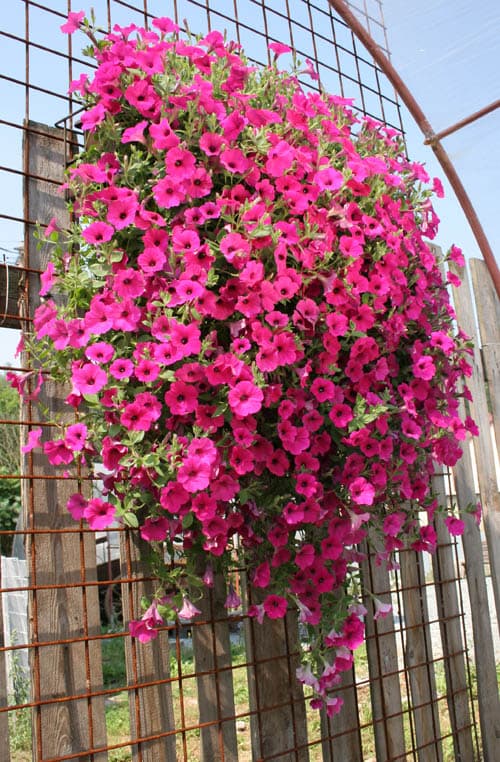A unique variety type in the world assortment, being the first cascading and truly large-flowered (grandiflora) petunia grown from seeds.
Flowers are intensely purple, with a diameter of 7.5-8.5 cm. The cascade reaches a length of 100 cm and is characterized by very intensive growth.
Like all other cascading petunias from the "Cerny" company from the "Diamond F1" series, they were originally intended for hanging pots, window boxes, and all places that allow showing the full beauty of the plant and emphasize its attractive and spectacular appearance.
This petunia can also be successfully used as a groundcover plant in flower beds and borders.
Value of this hybrid: high resistance to diseases, pests, and adverse weather conditions.
"Diamond Purple" F1 is the result of serious breeding work by the "Cerny" company.
* Pelleted seeds!
To facilitate the sowing and growing of small-seeded crops, a system of coating each seed with a special composition was developed. When moisture hits the pellet, the shell crumbles. Pellets are placed on the surface of slightly compacted and moistened soil without covering them, moistened from a spray bottle, covered with glass, and kept at a temperature of +20+24°C, preventing the pellet shell and compost from drying out until the seedlings germinate and periodically removing condensation drops from the glass surface.
Shoots appear only in the light (excluding direct sunlight) on the 10-15th day. After the appearance of the first true leaf, the crops are ventilated and subsequently the glass is removed, gradually lowering the temperature to +14+16°C.
Seedlings do not tolerate waterlogging well. Hardened seedlings are planted in the ground after spring frosts have ended at a distance of 15-20 cm.
Sowing: February-April for seedlings.
Care: petunia grows better in well-lit places with light, fertile soil. Responds gratefully to watering and regular feeding.
Flowering: from June until frost.

* Petunia is very light-loving (tolerates slight shading) and thermophilic, develops better on fertile, light, slightly acidic soils. With the onset of prolonged cold and rain, petunia stops flowering, and with the onset of good weather, resumes it again. Petunia is drought-resistant, however, with regular watering, it will thank you with more lush, beautiful bushes and abundant flowering.
For petunia seeds to germinate, warmth is needed (+23+25 degrees): then shoots appear in a week and a half. The top layer of earth in the pot with crops should not be wet, but should not dry out either, so shoots are checked often (at least twice a day). It is better to water petunia seedlings from below, from the tray. To avoid the appearance of "damping-off" (black leg), petunia shoots are periodically sprayed with a light solution of potassium permanganate after the soil dries, the glass is regularly turned over and wiped, and the "greenhouse" is ventilated.
Petunia seedlings are grown at a temperature of 20 degrees. Sparse planting of seeds allows for pricking out petunia seedlings when they develop 3-4 true leaves. But if necessary (rapid spread of "damping-off"), urgent pricking out of seedlings is carried out at earlier stages of development to save at least part of the crops. Before pricking out seedlings, the soil is moistened.
Petunia seedlings have a short hypocotyl and a rosette of leaves, so when pricking out, the seedling is pried with a stick, taken by the leaf, and carefully removed from the ground, keeping the soil on the roots. When pricking out, the growth point of the petunia cannot be buried in the ground, so when filling with soil, the cotyledons of the seedling are slightly raised above the ground. When petunia seedlings grow up, they begin to be fed (seedlings stretched due to lack of light do not need to be given nitrogen fertilizers).
Petunia seedlings are planted in the ground after the end of spring frosts, at a distance of 20-40 cm.
Petunia has branched roots that do not penetrate deep into the soil, so its root system recovers easily during transplantation.
Flowers from cuttings: if you managed to grow beautiful varieties and hybrids of petunias, in the fall transplant one plant into a pot.
Cut off long branches and put the flower to winter on the windowsill. Do not forget to water. It will look not very attractive, but with the arrival of spring, it will begin to grow rapidly.
Cut cuttings and root them in water (roots form most easily when the lower cut on the stem is made directly under the leaf).
A plant grown from cuttings fully retains all the properties of the mother plant.












